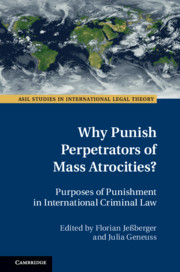Book contents
- Why Punish Perpetrators of Mass Atrocities?
- ASIL Studies in International Legal Theory
- Why Punish Perpetrators of Mass Atrocities?
- Copyright page
- Contents
- Contributors
- Preface
- Abbreviations
- 1 Introduction: The Need for a Robust and Consistent Theory of International Punishment
- 2 The Practical Importance of Theories of Punishment in International Criminal Law
- Part I Setting the Framework: Criminological, Historical and Domestic Perspectives
- 3 Criminology of International Crimes
- 4 Punishment Rationales in International Criminal Jurisprudence
- 5 Punishment and the Domestic Analogy
- 6 Not Much, but Better than Nothing – Purposes of Punishment in International Criminal Law
- 7 The Why Question in International Criminal Punishment – Framing the Landscapes of Asking
- 8 Is International Criminal Law Special?
- Part II Rationales for Punishment in International Criminal Law: Theoretical Perspectives
- Part III Consequences for the Practice of the International Criminal Court
- Select Bibliography
- Index
5 - Punishment and the Domestic Analogy
Why It Can and Cannot Work
from Part I - Setting the Framework: Criminological, Historical and Domestic Perspectives
Published online by Cambridge University Press: 07 February 2020
- Why Punish Perpetrators of Mass Atrocities?
- ASIL Studies in International Legal Theory
- Why Punish Perpetrators of Mass Atrocities?
- Copyright page
- Contents
- Contributors
- Preface
- Abbreviations
- 1 Introduction: The Need for a Robust and Consistent Theory of International Punishment
- 2 The Practical Importance of Theories of Punishment in International Criminal Law
- Part I Setting the Framework: Criminological, Historical and Domestic Perspectives
- 3 Criminology of International Crimes
- 4 Punishment Rationales in International Criminal Jurisprudence
- 5 Punishment and the Domestic Analogy
- 6 Not Much, but Better than Nothing – Purposes of Punishment in International Criminal Law
- 7 The Why Question in International Criminal Punishment – Framing the Landscapes of Asking
- 8 Is International Criminal Law Special?
- Part II Rationales for Punishment in International Criminal Law: Theoretical Perspectives
- Part III Consequences for the Practice of the International Criminal Court
- Select Bibliography
- Index
Summary
Elies van Sliedregt discusses the ‘domestic analogy’ and analyses the differences and similarities between domestic, i.e., ‘ordinary’, and international criminal justice. First, she distinguishes what she calls the domestic analogy ‘proper’ and the domestic analogy ‘of transplants’. While the former relates to international law and concerns the question of building a world order analogous to the domestic order and includes the question of the authority to punish, the latter refers to criminal law and the (unreflected) application of domestic concepts and theories on the international level. Focusing on the domestic analogy of transplants, she continues to extrapolate the sui generis nature of international criminal law, which she discusses in relation to the nature of international crimes, the perpetrators of international crimes and the punishing community. Van Sliedregt determines that today there is a move towards a communicative theory of international punishment, as well as an emphasis on reconciliation and reparations, and makes an argument for a stronger integration of rehabilitation, post-trial justice and reintegration into the international criminal justice system. In addition, she criticizes that in international criminal law there is no consideration for other forms of sanctions aside from incarceration.
Keywords
- Type
- Chapter
- Information
- Why Punish Perpetrators of Mass Atrocities?Purposes of Punishment in International Criminal Law, pp. 81 - 102Publisher: Cambridge University PressPrint publication year: 2020



